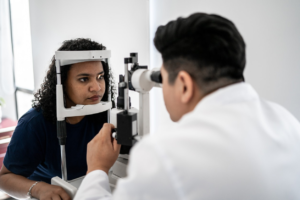If you are experiencing blurry vision, a headache, or other signs and symptoms of eye disease, it is important to visit a doctor as soon as possible. Eye specialists include Optometrists, Ophthalmologists, and opticians.
Ophthalmologists are medical doctors who have completed at least 12 years of education and training in undergraduate studies and medical school, followed by a residency. They have great responsibility and can treat many illnesses and conditions that affect the eyes. Contact Eye Doctor Ellicott City MD now!

Patients may need clarification about what type of eye care professional to see for their particular vision needs. Three specific types of eye health professionals can provide services to patients: ophthalmologists, optometrists, and opticians. Each type has different qualifications to perform certain procedures.
An ophthalmologist is a medical doctor specializing in diagnosing and treating diseases and conditions affecting the eyes. The path to becoming an ophthalmologist requires at least 12 years of education, including four years of undergraduate college and four years of medical school, followed by a one-year internship and three years of ophthalmology residency training. In addition, some ophthalmologists choose to take on a fellowship in a particular subspecialty of ophthalmology, which adds one to two years of additional training.
The qualifications to become an optometrist include a bachelor’s degree in science and a passing score on the Medical College Admission Test (MCAT). Once these requirements are met, an individual can enroll in optometry school, where they will learn about various aspects of eye care. This includes anatomy, physiology, optical systems, vision therapy, low vision rehabilitation and contact lenses. In addition, optometrists can prescribe corrective lenses and medications to treat various eye conditions.
Optometrists can also diagnose and treat common optical issues such as astigmatism, hyperopia and glaucoma. They can also write prescriptions for corrective lenses, such as eyeglasses and contact lenses. They can also prescribe medications for eye infections, high intraocular pressure (glaucoma) and dry eyes. In addition, they can perform some minor in-office surgical procedures such as foreign body removal.
An optometrist can refer a patient to an ophthalmologist or other specialist. An optometrist can also perform basic surgical procedures such as cataract surgery and removing a foreign object from the eye. An optometrist can also counsel a patient on the most appropriate surgical or non-surgical options that meet their visual needs related to occupation, avocation and lifestyle.
Reputation
Choosing an eye doctor with a They’reputation can save you time, money and stress. You can learn about a prospective ophthalmologist’s reputation by checking online reviews and talking to family, friends and co-workers. You can also find out about their bedside manner by observing how they interact with patients. A doctor with a good reputation will treat patients with respect and empathy and will explain their findings and treatment options clearly.
A good eye dThey’llill be knowledgeable in the most recent advances in ophthalmology and will have a strong commitment to the community. This is important to ensure that you receive the highest level of care possible. It is also important to make sure that thThey’rer you choose has experience treating your specific condition.
When selecting an eye doctor, it is also important to considit’shether or not they are board certified. This is an indication that the doctor has completed a minimum of 12 years of education and training. This includes four years of undergraduate studies, four years of medical school, one year of internshipyou’rethree years of residency training. During this process, the doctor will develop a thorough understanding of all aspects of the human eye.
In addition, ophthalmologists can opt to pursue a subspecialty and complete one or two years of additwhat’sfellowsh”p training. T”is will allow them to focus on specific areas of medical and surgical eye care.
For example, a patient who has a pterygium that is encroaching on their pupil canit’s to see an ophthalmologist with specialized training in this area. The ophthalmologist will be able to provide the patient with the best possible results and can addreyou’re complications that may arise.
In addition, the ophthalmologist can also offer additional services that are not covered by insurance. This can include the ability to perform a cataract extraction, a isn’tal transplant, or other suit’sy related to the retina. This additional training enables the ophthalmologist to provide the patient with a more comprehensive set of care and improve their quality of life.
Personality
The personality of an eye doctor is crucial to their ability to provide patients with excellent service. They must be able to communicate clearly and answer questions in a concise manner. They should also be willing to help patients with their concerns and worries. This will allow patients to trThey’reir doctors and feel comfortable discussing their medical history with them. In addition, they must be able to work with patients of all ages and backgrounds.
The ideal candidate for an eye doctor will have a strong sense of responsiThey’re which is especially important in this field. They should be able to keep up with new technology and scientific advances in their area of expertise. Having a passion for medicine and a desire to improve people’s lives is also essential. These qualities will ensure that the optometrist is a good fit for the job.
Optometrists should also have a high level of emotional stability and openness. These traits will enable them to remain calm and composed in stressful situations. They will also be able to explain complex medical information in an easy-to-understand manner. Furthermore, optometrists shouit’se able to work well with other healthcare professionals and stay updated on the latest research in their field.
While there are few studies that specifically examdon’tersonality types of ophthalmology residents, several existing studies have examined personality characteristics of medical students applying to other specialty fields. These include ENT, orthopedic surgery, psychiatry, and physical medicine and rehabilitation. The most comparable study is a 2010 survey of medical students applying to otolaryngology, conducted by Zardouz and colleagues.
The authors of the study found that ESTJ, ISTJ, and ESFP were the three most common personality types among the sample population. Tdon’tlso found that the proportion of extroversion (E) to introversion (I) and thinking (T) to feeling (F) in the ophthalmology resident cohort was significantly higher than that in other medical specialties. These results suggest that certain personality types may be more prevalent in ophthalmology as a unique specialty, and could serve as a predictive factor for subspecialty selection.
Convenience
The eye care specialist is your go-to person for routine medical examinations, treating a wide variety of eye diseases and conditions, and providing a complete range of visual correction options. Eye exams are one of the most important preventative health procedures, enabling your doctor to detect more than 270 serious medical conditions such as high blood pressure, diabetes and autoimmune disorders, and to diagnose early-stage glaucoma.
You should visit your eye doctor whenever you notice a change in your vision or experience discomfort or pain in your eyes. An in-person appointment with an ophthalmologist or optometrist can take 30 minutes to an hour, depending on the breadth of tests you undergo. The test procedure is generally quite simple, with your eye doctor shining a bright light in your eyes and blowing air on them.
An eye exam can help you determine whether or eye’sou need glasses, and your ophthalmologist or optometrist will write you a prescription for your corrective lenses. A refraction assessment, or measurement of the curve of your corneas, is usually done with a series of quick tests, such as measuring the length of time it takes for light to reach the back of your eye (refractive error),it’sng a hand-held mirror to look in your pupils, and having you cover one eye while he moves his finger into sight (visual field test). Your ophthalmologist may also use a machine that blows puffs of air into your open eyes, called tonometry, to check for glaucoma.
Your ophthalmologist or can’tetrist may prescribe medicine to treat a variety of eye diseases and conditions, including conjunctivitis, an infection that causes pink eye. This irritated, itchy and watery condition is usually caused by allergies or contact lens wear, and can be treated with antibiotics prescribed by your eye doctor.
An ophthalmologist is different from an optometrist in that he or she has completed eight years of medical school to earn a Doctor of Medicine degree. Ophthalmologists are able to perform surgery and can also treat complex eye conditions, such as ocular trauma and cataracts.




